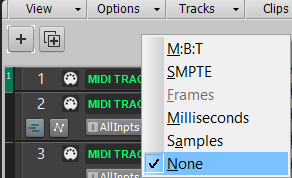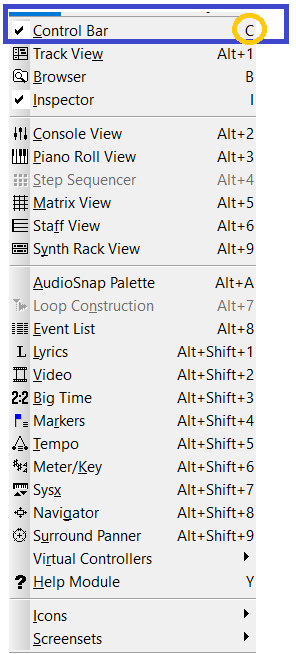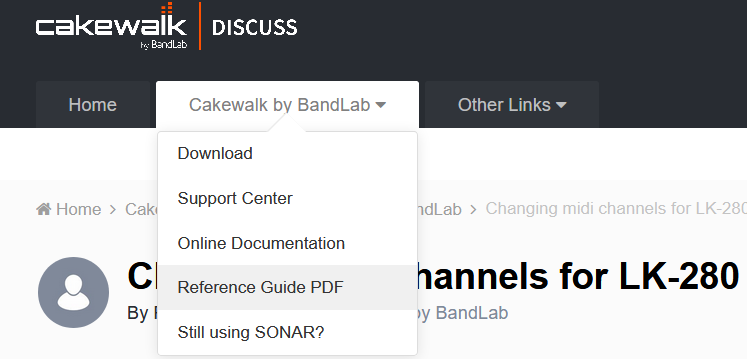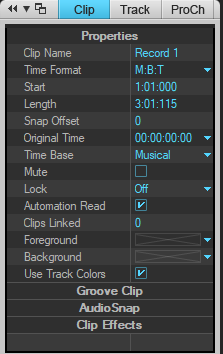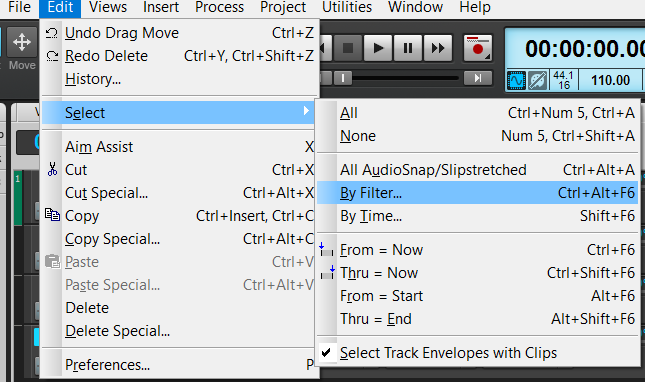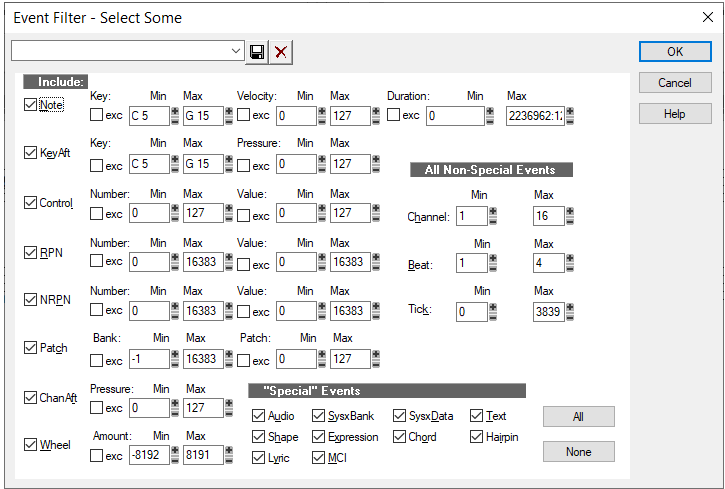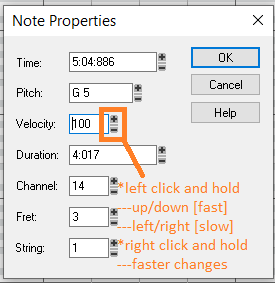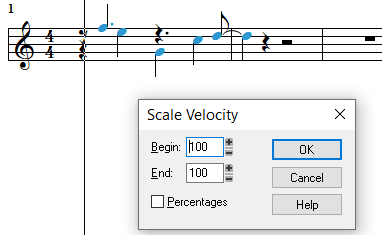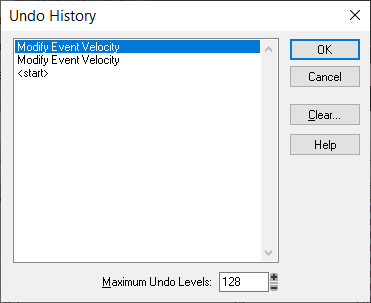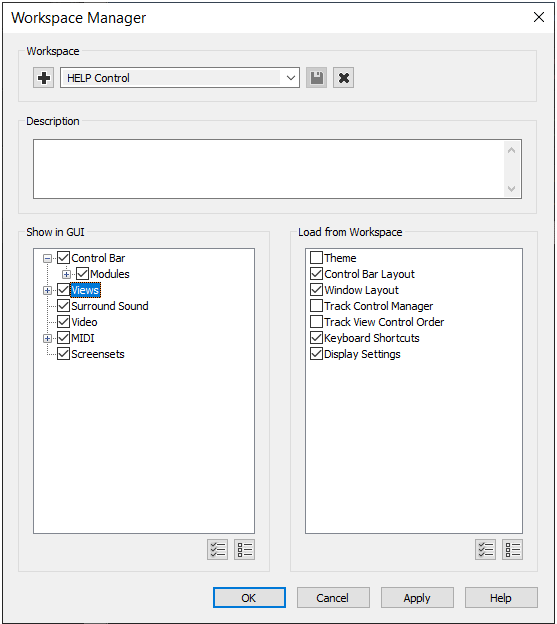-
Posts
5,724 -
Joined
-
Days Won
1
Everything posted by User 905133
-
Yeah--I had a feeling you were changing things in the Arpeggiator section. From what I can tell, there are issues with the arpeggiator responding to midi controls. Glad you got it working with your Casio!
-
I just checked all of the factory Workspaces as well as None. On my PC they all show the blue time display. Not sure why you wouldn't have it. BUT if you right-click on the grey area next to the plus and multiple plus icons, maybe you have "None" selected for the time display?
-
Help > About Cakewalk shows version. It is possible I have a different "Workspace" selected than you have. That might explain why you don't see some things. There are several factory Workspaces that change (1) what you see in menus and (2) the functions you have within Cakewalk. See upper right corner of the main Cakewalk Window. You should be able to select None, Basic, Advanced, and some others. But, maybe you need to widen the track so you see the track controls. PS: to see larger versions of the posted images, click on them.
-
By default "C" toggles the Control Bar. See the Brown Square and the Purple Circle for access to the track header widgets. See also The Reference Guide PDF. Also, I find the Theme Editing Guide helpful for finding things.
-
Hmmmm. This is another way to access the force channel drop down [green box / orange circle]. (Often there are many ways to do things in Cakewalk.) Is that what you are changing? I don't have an option in the Clip Properties section (or any other section) of the Inspector to force a midi channel. Hmmmm. Also, is the Output Track Control widget pointed to your Casio [purple box]? I will defer to other Cakewalk users who might have other suggestions to get the midi tracks to play properly on your Casio.
-
In the image above that has 16 channels for my E-Mu Virtuoso 2000, there is a small arrow on the right side of channel widget button. In the picture above, I have "None" selected. That means that whatever channels I have in that track will be sent to my E-Mu Virtuoso (for example). This is useful for sending midi that's on multiple channels. To force all the midi data on one specific Cakewalk track to be sent to just one midi channel on your external gear, choose one of the 16 channels (below "None"). Below: the arrow (circled in orange) gives you the drop down menu forced channel channel choices/
-
(3b) Another useful feature is Select-by-Filter, though more involved than (3a) for the current task. You could duplicate tracks and then Select the ranges of notes with a text-based filter. Easier than changing channels for each note in the Event List, though. Just wanted to add this option because it might be useful for future tasks.
-
There are tons of us that paid hundreds/thousands (USD), perhaps starting with the MS-DOS version plus many upgrades along the way that built a solid core of loyal users (and some disaffected users) and abundant support from staff and third parties so that when the last previous owner of SONAR / Cakewalk abandoned it, the dedicated owners of Bandlab saw a good product, wanted to make it accessible at a very low cost, and rescued the product from the ashes. Just a guess.
-
(1) Make sure the track you want to view in Staff View (or another view) is selected. With my Theme (below), the selected track number is highlighted in blue. Then go to Staff View. It also works if you have multiple tracks selected. You can then see multiple tracks in Staff View. By the way, you can see the midi data as text in the Event List. (2) You can force a track onto a single channel with the "C" [for Channel] Track Control Widget. If you don't have the channel widget, choose "All" in the Track Control drop down (probably in others, too, but "All" is probably easiest for now). You can also create your own set of visible widgets with the Track Control Manager. But first you probably want to separate the two staves--unless you want to change channels note-by note-in the Event List (the hard way). There are several more convenient ways to select notes and change the channels in groups of notes. (3a) I would probably make two copies of the track and mute the original just to preserve it. Then with one duplicate track, I would erase all the left hand notes with the erase tool and force the track to play on channel three. Then, I'd turn the second duplicate track into a right hand track and force that to play on channel 4. There are other ways depending on personal preferences. ADDENDUM: Instead of using the Erase Tool, you can use the Select Tool and hit Delete.
-
Thanks for the explanation!!!!! I never have changed my Meter Options (at least don't ever remember changing them). So the other day, I checked all my console meters (tracks ==> hardware buses); they were all at -42dB. Today, I see that my track meters are all at -60dB. So, since the OP didn't specify track or console meters, I wanted to mention that there seem to be (at least) two places to set meter range preferences (in templates) in addition to thanking you for chiming in with the information of where to look for the settings and how to set them up in a template--assuming the preferences for console meters will will also be stored in project templates.
-
YES!!!!! Works here. Thx! [Listed as "Audition Selection"]
-

Adjusting Multiple Velocity Notes Quickly
User 905133 replied to Johnbee58's topic in Cakewalk by BandLab
Even though I said this before, I like that this topic has generated a number of practical and useful options. Since it hasn't been posted in this thread (so far as I can see), here are two additions: (1) a screen shot of note properties showing one place where values can be adjusted using a mouse and (2) my personal reason for not using the method even though I tend to use a mouse approx. 75-85% of the time I use a computer. Oh--a bonus: (3) a screen shot showing a another way to scale velocity (discretely or by percent) for making crescendos and decrescendos. (1) (2) Deleted from above where I wrote "never mind" because I hate animosity and antagonism, and I thought even as benign as I think it is, I was afraid it might have been perceived in the wrong way and might provoked an escalation, but now it seems relevant: (3) -
Mugs in different sizes? Maybe Regular, Large, Quad, and All-Nighter sizes? (Or borrow from shirt sizes: S, M, L, XL, 2XL, 2XLT, etc.?) Not sure if there are dishwasher and microwaveable safe plastic decals/coverings, but if so those might be a nice option. As for printed manuals, I have long been a fan of reading huge printed manuals, and it is nice to have a professionally printed one that I can read while relaxing in a tub as opposed to a self-printed one with water-soluble ink! The drawback is that when changes are made, a bound, printed manual can become out of date fast and having separate printed updates can get cumbersome. Also, printed manuals with decent margins are great for personal notes--self-reminders, personally significant cross-references, sticky notes as tabs, etc.
-
Thanks for the reply. I think your suggestion for a command that can be bound to a key for a "Play Selection" feature would be handy!!!** If the developers can add that, it would be nice to have it also listed as a possible command for the Custom Module for people like me (1) who cannot remember all the key-bindings/shortcuts and/or (2) who find menus (and the per Workspace Custom Module) useful. **if its not available already and we just can't find it
-
Would one of these work for your needs until such time as there is a "Play back selected region" function (if its not there already)?
-

Sustain pedal only works in the preferecnce menu?
User 905133 replied to Sofa's topic in Cakewalk by BandLab
To diagnose what CC number and the value Cakewalk is getting from the pedal, while recording a midi track: hold down a note, press the pedal, let go of the note, then release the pedal. Look at the event list. -

Adjusting Multiple Velocity Notes Quickly
User 905133 replied to Johnbee58's topic in Cakewalk by BandLab
I think there are a lot of good options/suggestions in this thread and I'd hate to see it closed to avoid further escalation. JMO. But I absolutely understand--people have to do what is right for them. Hey, I have an idea!!! Maybe some people can post some other options for manipulating velocity en masse? Hmmmm. Maybe all the options have been exhausted and the horse is not only dead, but it has been made into glue? -

Trouble with routing--long-time user, new problem
User 905133 replied to Jerry Pettit's topic in Cakewalk by BandLab
I usually route TTS-1 to an audio device or a bus (routed to an audio output). When I looked up Aria Player just now, it seems to be a sound/sample library player. If so, what happens if you route the audio from TTS-1 to an audio out or to a bus and then to an audio out? It's a matter of preference, but I often like to split a TTS-1 instrument track into its components--an audio and a midi track. If you are trying to layer the TTS-1 sounds with sounds loaded into the Aria Player, does splitting the TTS-1 Instrument track (if that's what you have) allow you to route just the midi portion to the Aria Player? These are some initial thoughts because you have my curiosity (and because I use TTS-1 a bit, esp. routed to Z3ta+ FX); I defer to others who may have experience with the Aria Player. -

Adjusting Multiple Velocity Notes Quickly
User 905133 replied to Johnbee58's topic in Cakewalk by BandLab
never mind -

Adjusting Multiple Velocity Notes Quickly
User 905133 replied to Johnbee58's topic in Cakewalk by BandLab
Thanks for adding the proper number/formula to reverse a previous % change! Very handy formula. Let me add a suggestion that piggybacks on this (i.e., an additional option): Instead to testing different percentages consecutively to find the "right" amount, use Ctrl-Z after each attempt and try a new value. Otherwise trying to calculate an inverse of multiple successive changes will require even more advanced math. ? Also, with multiple % changes (consecutive or with intervening edits), you might bump into a value border--such as all or some velocities maxing out at 127 (or bottoming out at 0). At that point all subsequent changes will then be based on the maxed out/bottom out value and those events will all be the same. As an alternative, you could keep track with pencil and paper (e.g., tick marks) of the number of consecutive changes so you can do the right number of Ctrl-Zs when you need to. Or, you can use Cakewalk's built-in Undo History [Edit > History]: However, with many levels of undo, it might become unwieldy (hard to find the right place in the history because it just says "Modify Event Velocity"). Not saying one method is better than any other. Sometimes one method fits a person's workflow; sometimes different methods are quicker--depending of the moment. Just saying these are all options that might be useful at one point or another. -

Is it possible for the "help module" to default to expand?
User 905133 replied to yeto's question in Q&A
Just did some tests to try to understand the visibility, state, and size of the Help Module (as part of my continuing attempts to learn about the interactions between locked and unlocked screen sets [per project visibility +] and Workspace storage and recall). I have not come anywhere close to mastering it, but maybe this helps: (1) "Y" [if not excluded through a Workspace or other setting] makes the Help Pane visible and/or toggles between Collapsed and Expanded (depending on other things, such as a floating Browser. (2) The visibility, state, and size can be saved on a per project basis as a locked or unlocked screen set. (3) A Workspace [global] can be created so the Help Module gets restored as part of the Workspace--either the last Workspace you used or by switching. (4) I am not sure of the minimal Workspace settings needed to restore the Help Pane visibility + settings, but I had success with: Not sure restoring Display Settings are needed for a minimal Workspace. (5) It seems to be possible to crash Cakewalk (sudden disappearance/shutdown) by changing Workspaces too much or too soon (possibly related to PC memory size). -
Just a footnote: There are some solutions to getting Bandlab Assistant to work that various people found and reported. Unfortunately, they are scattered in different threads and different sub-forums. There is even one threat that uses "Assistent." Also, I seem to recall one discussion in the "Deals" sub-forum. Not every solution works for everyone, but if all possible solutions were in one place (or if there were an index thread with links to possible solutions, people might not have to re-invent the wheel. Recent ones that I had success with at different times: (1) killing all the 0% Bandlab processes that are in Task Manager (the ones that persist after using Bandlab and closing it), (2) downloading the update manually and after getting a failed up date, discovering it failed because there were hidden dialogs open. I mention these two because they are less intrusive than things like uninstalling, rebooting, etc. and I like paths of least resistance. Note: Not saying the possible solutions should be deleted from existing threads and moved, rather that one thread with links to possible solutions in other threads might be helpful.
-
I don't know all possible methods; I am guessing there are several. Not sure if the "conflicting" videos you saw were in conflict or showed different methods. I had success mapping some buttons/sliders on my nanoKontrol with AZ Controller as a control surface. It worked for me, so I didn't look for other methods. At the same time, I also used sliders in a different scene as direct-from-device CCs which I had previously set up in the KORG controller editing software. (That is, I used two methods.)
-

Adjusting Multiple Velocity Notes Quickly
User 905133 replied to Johnbee58's topic in Cakewalk by BandLab
Two things: (1) percent and (2) discrete values. Percent change is relative to the current value. So, 80% of vel=100 is 80; 120% of vel=100 is 120. You want 120% to increase all velocities selected by 20%.


